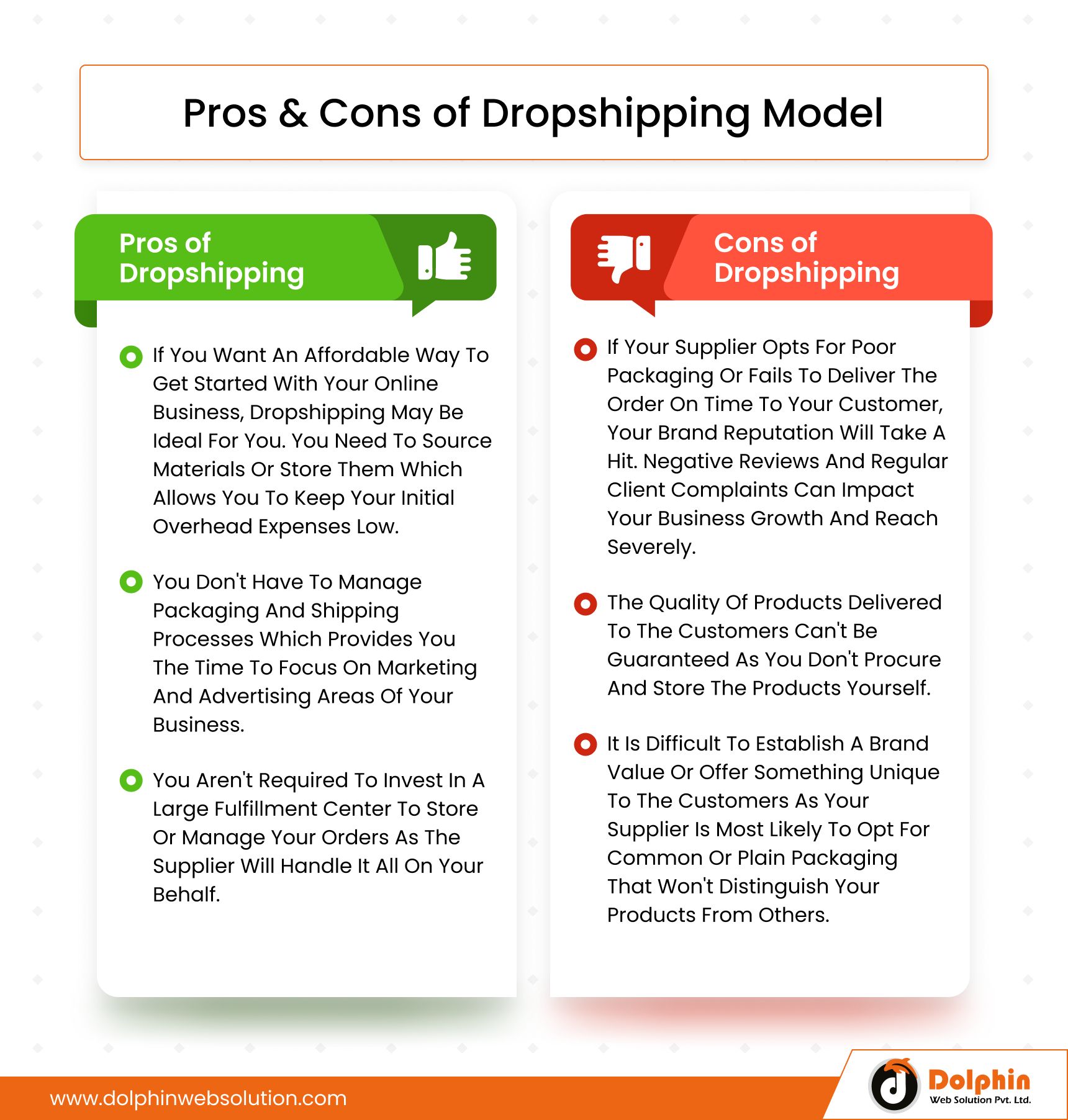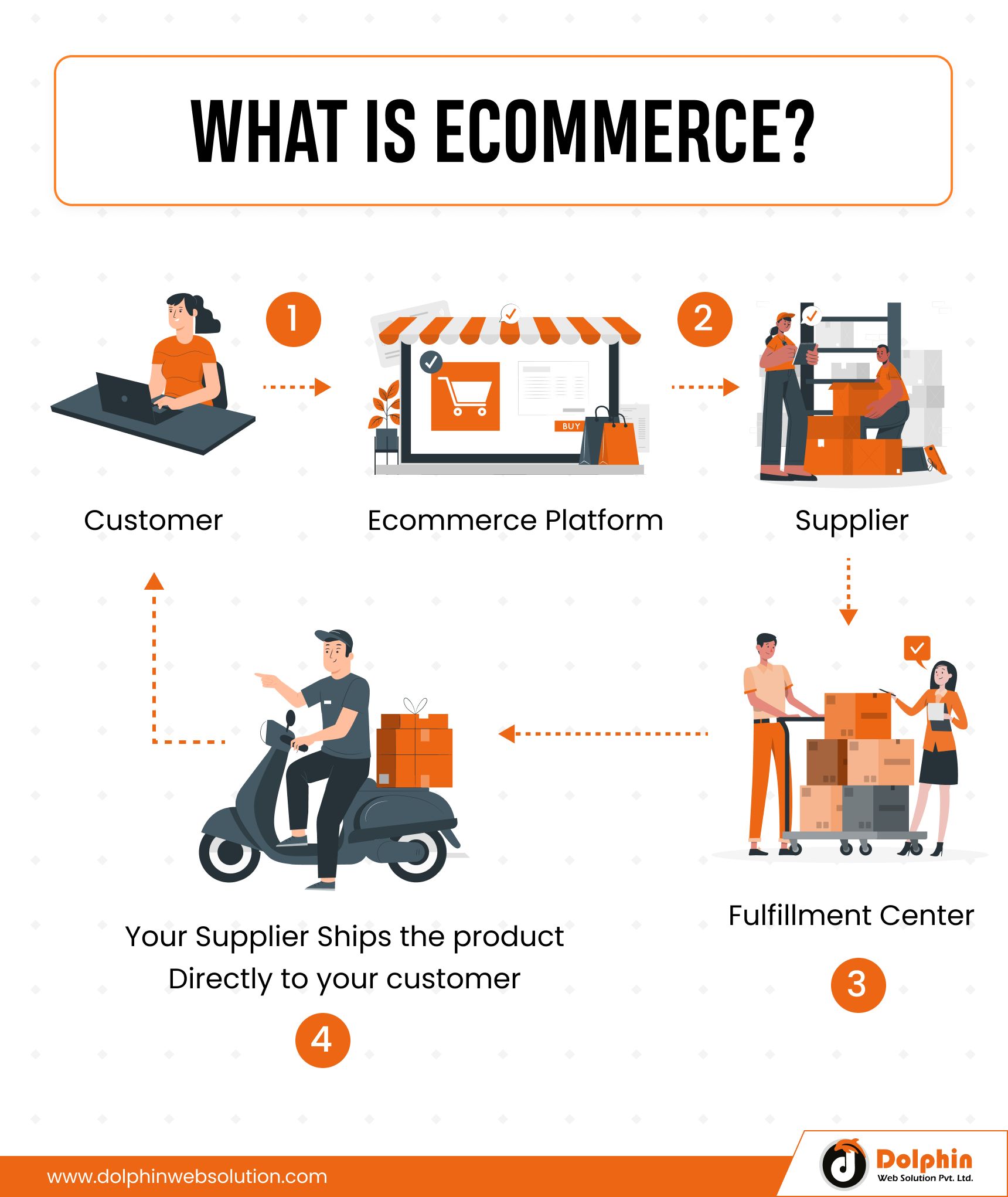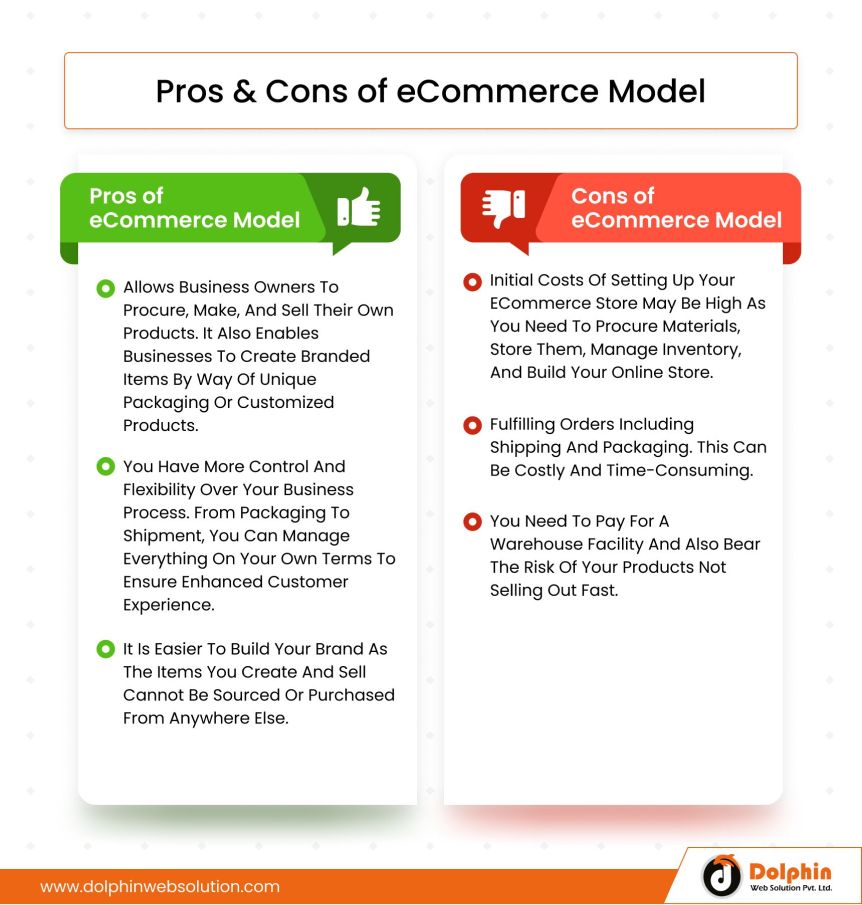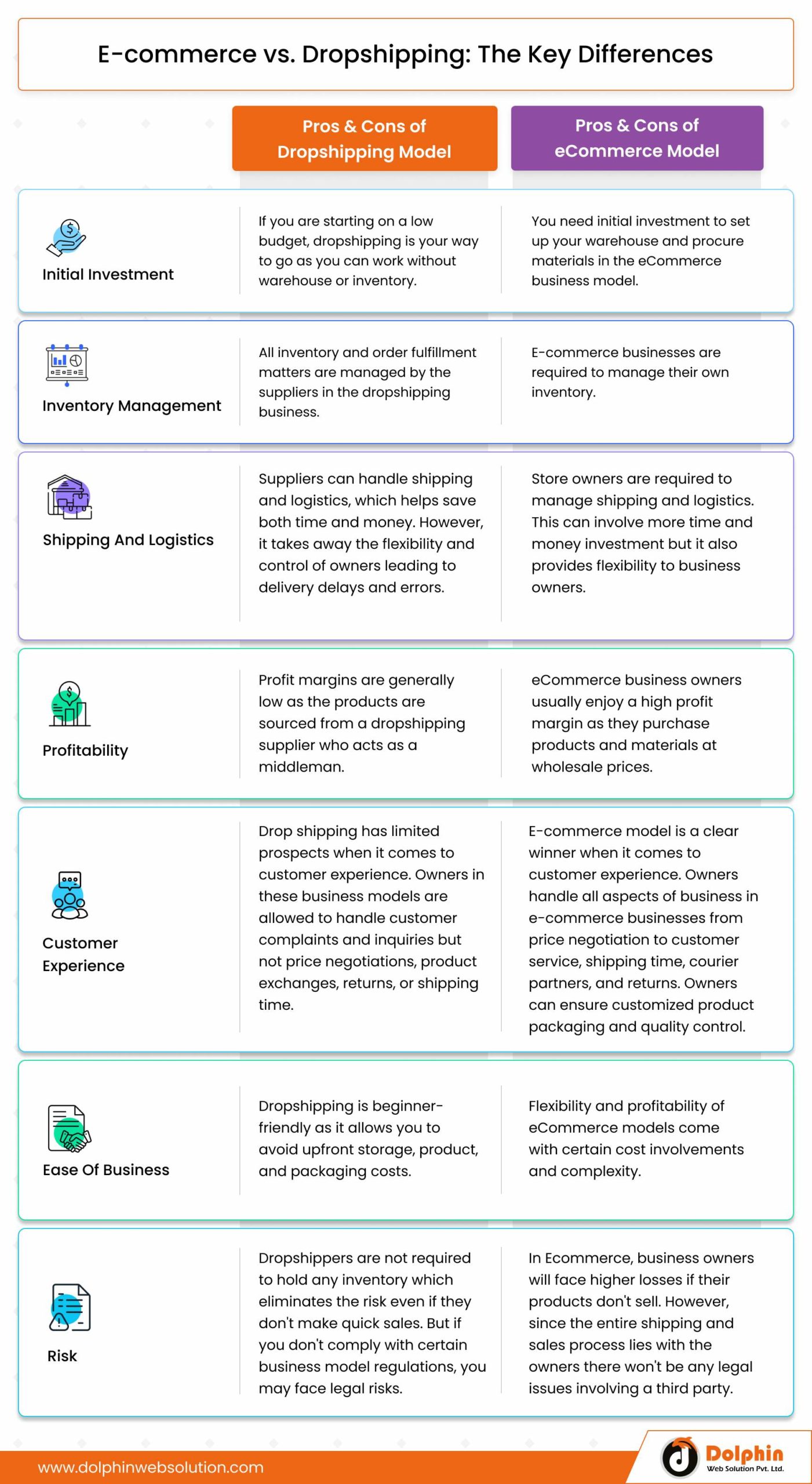Dropshipping vs eCommerce: The Pros & Cons of Each

Table of Contents
Summary :
Read our blog for the critical differences between dropshipping and conventional eCommerce. Find out more about prices, marketing tactics, client experiences, and scalability to assist you in making intelligent choices for your online business.
In the last decade, the accessibility and usage of the Internet have increased tremendously. The continuous advancement of technology coupled with the modern needs of society, made online stores a thriving business prospect. The enhanced user experience, secured online payment, diverse item choices, and 24/7 accessibility are making customers hooked to online stores.
If you wish to enter this flourishing niche, then you must choose an online business model that syncs with your business goals including the long-term ones. In this article, we take you through the two most popular online business models and their key differences.
What is Dropshipping

The dropshipping business model allows businesses to establish an online store and sell items without storing inventory or handling logistics. On receiving an order from a customer, the retailer will forward it to a supplier or another company. The supplier will then pack and ship the item to the shipping address of the customer as provided by the retailer.
In the dropshipping model, the businesses create a website to showcase the items to their target audience and sell. The retailer sources items from a manufacturer or supplier and sells them through a website or app.
A customer may visit the online store of the retailer and place an order of items. The retailer will then pass all the order details to the supplier including the payment information and shipping address. The supplier will ship the order directly to the customer on behalf of the drop shipper.
Pros of Dropshipping
- If you want an affordable way to get started with your online business, dropshipping may be ideal for you. You need to source materials or store them which allows you to keep your initial overhead expenses low.
- You don’t have to manage packaging and shipping processes which provides you the time to focus on marketing and advertising areas of your business.
- You aren’t required to invest in a large fulfillment center to store or manage your orders as the supplier will handle it all on your behalf.
- It allows you to sell your items not only on your own website but also on recognized online platforms like Amazon, eBay, and others.
- You can offer an extensive choice of items without the risk of being left with unsold inventory. When you offer a diverse range of products, you are more likely to reach a larger customer base.
Cons of Dropshipping
- If your supplier opts for poor packaging or fails to deliver the order on time to your customer, your brand reputation will take a hit. Negative reviews and regular client complaints can impact your business growth and reach severely.
- The quality of products delivered to the customers can’t be guaranteed as you don’t procure and store the products yourself.
- It is difficult to establish a brand value or offer something unique to the customers as your supplier is most likely to opt for common or plain packaging that won’t distinguish your products from others.
- In the dropshipping model, you are required to source your items from a third party which may increase the cost price of the product and reduce your profit margins.
- This model restricts you from handling the shipping and order fulfillment process yourself. But if your supplier is not good with these processes, it can lead to more refund requests and customer complaints.

What is eCommerce?
eCommerce is the purchasing and selling of products via the internet by way of online services. Online business transactions form the heart of eCommerce. With eCommerce, businesses can operate 24/7 and allow customers to reach out to them at any time. You can also reach a global customer base when you opt for eCommerce business models as they eliminate the constraints of traditional business stores such as fixed business hours or physical store presence.

Choosing an eCommerce platform, setting up your online store, selling products, creating a secure payment gateway, and shipping the products are all part of the eCommerce business. The possibility for scalability and greater convenience has caused thousands of businesses to transition to online business operations in recent years.
The eCommerce fulfillment process starts when a customer orders something online and provides details to the vendor including payment information and shipping address. The seller will then prepare the product for dispatch and handle all packing and shipping requirements. The order will be shipped to the customer through a separate shipping company or by the own shipping department of the company. The customer can track the shipment progress till the order gets delivered. Once delivered, the customer can request exchanges or refunds, if needed.
Pros of eCommerce Model
- Allows business owners to procure, make, and sell their own products. It also enables businesses to create branded items by way of unique packaging or customized products.
- You have more control and flexibility over your business process. From packaging to shipment, you can manage everything on your own terms to ensure enhanced customer experience.
- It is easier to build your brand as the items you create and sell cannot be sourced or purchased from anywhere else.
Cons of the eCommerce Model
- Initial costs of setting up your eCommerce store may be high as you need to procure materials, store them, manage inventory, and build your online store.
- Fulfilling orders including shipping and packaging. This can be costly and time-consuming.
- You need to pay for a warehouse facility and also bear the risk of your products not selling out fast.

E-commerce vs. Dropshipping:The Key Differences
eCommerce and dropshipping come with different features and will impact your online store in different ways. To help you choose the best eCommerce business model, we have pointed out the key differences between eCommerce and dropshipping models.
Initial Investment
If you are starting on a low budget, dropshipping is your way to go as you can work without warehouse or inventory.
On the other hand, you need initial investment to set up your warehouse and procure materials in the eCommerce business model.
Inventory Management
All inventory and order fulfillment matters are managed by the suppliers in the dropshipping business.
On the other hand, e-commerce businesses are required to manage their own inventory.
Shipping and Logistics
In the dropshipping business model, suppliers can handle shipping and logistics, which helps save both time and money. However, it takes away the flexibility and control of owners leading to delivery delays and errors.
In eCommerce, store owners are required to manage shipping and logistics. This can involve more time and money investment but it also provides flexibility to business owners. They can make shifts, address delays and errors, choose preferred couriers, and ensure better shipping solutions.

Profitability
In dropshipping, the profit margins are generally low as the products are sourced from a dropshipping supplier who acts as a middleman. Dropshippers often face an expensive supply chain as they need to spend for fulfillment services.
eCommerce business owners usually enjoy a high profit margin as they purchase products and materials at wholesale prices. Moreover, with complete control over their shipping and logistics, they are able to minimize product packaging as well as shipping costs.
Customer Experience
Drop shipping has limited prospects when it comes to customer experience. Owners in these business models are allowed to handle customer complaints and inquiries but not price negotiations, product exchanges, returns, or shipping time. They don’t get much flexibility to customize packaging or product quality.
The E-commerce model is a clear winner when it comes to customer experience. Owners handle all aspects of business in e-commerce businesses from price negotiation to customer service, shipping time, courier partners, and returns. Owners can ensure customized product packaging and quality control. This will also allow the owners to opt for unique branding and create a powerful brand image in the market.
Ease of Business
Dropshipping is beginner-friendly as it allows you to avoid upfront storage, product, and packaging costs. On the other hand, the flexibility and profitability of eCommerce models come with certain cost involvements and complexities. You need to procure, store, and ship products. This will require an experienced workforce.
Risk
Dropshippers are not required to hold any inventory which eliminates the risk even if they don’t make quick sales. But if you don’t comply with certain business model regulations, you may face legal risks.
In contrast, business owners will face higher losses if their products don’t sell. However, since the entire shipping and sales process lies with the owners there won’t be any legal issues involving a third party.
When to Choose Dropshipping
In the following situations, you can choose a dropshipping model for your online business:
- You are new to the online store market and want to bring your store to life quickly.
- You wish to sell products that are not unique or don’t require branding.
- You don’t have the financial resources to invest in a costly startup or overhead costs.
- You don’t wish to take the risks associated with unsold inventory.
When to Choose eCommerce?
You can opt for the eCommerce model in the following cases:
- You have the financial resources to spend on costly overheads.
- You have a capable workforce to handle all inventory, shipping, logistics, and other product-related services.
- You want flexibility and control in your business processes.
Key Takeaways
Both eCommerce and dropshipping business models can be profitable if you know your business goals well. Understand which fulfillment process will work best not only for your current business situation but also for your long-term growth plans. While eCommerce fulfillment requires a higher initial investment, it can be highly rewarding in the long term if stability, brand value, and loyal customers are your goals. On the other hand, if you wish to start with minimal investment and risk yet get the benefits of operating online, dropshipping can be your way to go. If you need an ecommerce developer then connect with us.

Hello!
Click one of our contacts below to chat on WhatsApp

